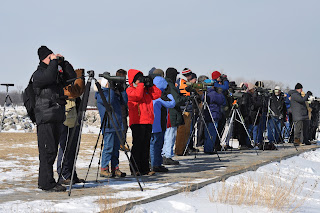 |
| Ross's Gull on Chicago lakefront, March 2023. Photo by Matt Zuro |
Embracing the challenge of gulls
(published 1-22-25)
Gulls are a little scary. They frighten me. I don’t mean literally, in a Hitchcockian sense. The nightmare comes in trying to sort out their identities.
Skilled birders usually thrive on ID challenges, while others
stand back and leave the dirty work to the experts. With gulls, I’m in the
latter camp. The intimidation factor is high.
The main issue is plumage variation by age. For some gull species,
the transition to adulthood may take four years, with different looks at every
stage. Annual feather molt can add further confusion.
Bill, eye and leg colors may change, too. The Black-legged
Kittiwake, a small, tern-like gull, does not always display black legs!
Fortunately, help is out there. It comes in the form of Amar
Ayyash, a high school math teacher from Orland Park who happens to be one of
North America’s top authorities on gull ID. He’s on a mission to make gull
watching more fun and less frustrating for birders.
 |
| Amar Ayyash and "The Gull Guide." |
Ayyash views gull-watching differently. “The fact that it’s challenging makes it appealing,” he told the Wall Street Journal in a 2018 page-one story about the trickiness of gull ID.
Even Ayyash is sometimes stumped, although such occasions
are rare. His depth of knowledge is remarkable, acquired from two decades of close
gull observation. He readily admits to being obsessed with gulls.
Ayyash operates the website anythinglarus.com, and just published “The Gull Guide,” a 500-pager covering all 36 species found in North America. The book’s introduction offers a framework for how to think about gulls as a group and explains their unique place in the avian world.
In December, Ayyash won the Robert Ridgeway Award for
Outstanding Ornithological Publication from the American Birding Association
(ABA). “The Gull Guide” is already in its second printing by Princeton
University Press.
Ayyash began a national book tour in October. I’ve heard him
speak three times so far, including the bird club visit and his appearance on
the ABA podcast. He is often asked for tips on how novice birders can overcome their
fears about gull ID.
 |
| Our region's two most common gulls: Herring Gull, foreground left, and Ring-billed Gull, right. Photo by Amar Ayyash |
Lucky for us, gulls are accessible birds—easy to find and
watch. Beaches and shopping center parking lots are good places to look. Gulls
are opportunistic feeders, built for survival.
Ayyash recommends getting close to birds on the ground and observing them. If you can, take photos for later study, including flight shots. For gulls in the air, wing tip patterns are the best ID clues.
In this region, winter is prime time for gull-watching along
Lake Michigan. Next month, in fact, is the Gull Frolic, a one-day watch party hosted
by the Illinois Ornithological Society at North Point Marina in Lake County.
Ayyash coordinates the Frolic, now going on 23 years and
always a sellout. His annual wish list includes non-frigid weather, open water,
and a rare gull or two. A timely sale on white bread would be welcome, too—the
Frolic requires dozens of loaves for “chumming.”Gull Frolic birders at North Point Marina in
Winthrop Harbor, Illinois.
But as with every kind of birding, patience and attention to detail usually pays off. With gulls, that often means picking out something different from a sea of gray and white birds. Finding a rarity is always the goal.
A California Gull appeared at the 2024 Frolic, thrilling the
chilly spotters. Three months later, a Black-tailed Gull visited Waukegan
Beach.
Several gulls, Ayyash writes, are among “the most coveted
bird species on the planet.”
 |
| Ivory Gull in Quincy, Illinois, January 2015. Photo by Jackie Bowman |
Ayyash still reflects on the adult Ivory Gull he encountered
in early January 2018, at the Lake County Fairgrounds in Grayslake. He was alone,
checking the parking lot—a reliable gull hangout because it’s near a landfill. The
temperature was below zero when a small, pure-white bird dropped into plain
view, gifting Ayyash an unforgettable holy grail moment.
List-chasing birders do love a rare gull. The fairgrounds Ivory Gull didn’t stick around but another one did, three years earlier in downstate Quincy. Birders throughout the Midwest hustled to see it, the state’s first Ivory in 20 years. Only four records of Ivory Gull exist for Illinois.
For the everyday “seagulls” to the rarities, Ayyash urges us
to give gull-watching a fair chance. We can learn from gulls, and perhaps come
to admire their tenacity and versatility. Some are quite beautiful, too.
In his book, Ayyash notes that no gull species is known to
have gone extinct. They are out there, available for watching, in all kinds of
weather.
Copyright 2025 by Jeff Reiter. All rights reserved.
